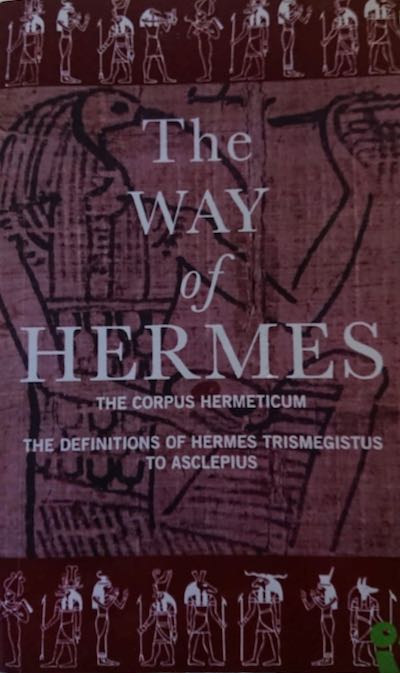In the year 1460 a monk brought a Greek manuscript to Florence. The monk, Leonardeo of Pistoia , was one of the agents that the city ruler, Cosimo de’ Medici, had sent to scour Europe’s monasteries for gotten writings of the ancients, and what he now brought his patron was a codex containing fourteen treatesis attributed to Hermes Trismegistus, an ancient Egyptian sage. This work’s arrival caused a great stir, because Hermes, identified with the Ibis god Thoth, was held to be older than Plato and Moses and the underlying inspiration of all philosophy and religion that followed him. Cosimo immediately instructed his scholar Marsilio Ficino to suspend his project of translating the dialogues of the divine Plato so that he might undertake a traqnslation of this even more significant work.
This manuscript contained the nucleus of the Corpus Hermeticum, als falsely called Pimander, after the first treatise, Poimandres. Along with some astrological and alchemical works, also named after Hermes, these tracs became the fundamental writings of the Renaissance, together called Hermeticism, whereas the doctrine of the Corpus Hermeticum is called Hermetism. The texts of the Corpus are preserved in Greek, and appear to have been produced between the first and third centuries AD in Alexandria, Egypt.
In 1614 the Swiss Calvinist from Geneva, Casaubon, proved that the Coprus Hermeticum was not as old as it preternded to be but should be dated after the beginning of the Christian era. After this Hermetic writings lost their general fascinition but lived on in secret societies as the freemasons and the Rosicrucians.
The discovery of Hermetic writings in one of the thirteenth codices found near Nag Hammadi in Egypt 1945 changed this situation completely. They contained a better version in Coptic of parts of the Hermetic Asclepius, preserved in Latin among the works of Asclepius, and moreover, the integral text of an unknown writing called ‘On the Ogdoad and Ennead.’ This work shows without any doubt that the Hermetic believer was initiated into several grades before transcending the sphere of the seven planets and heaven of the fixed stars (the Ogdoad). Then he would behold the God beyond and experience Himself.
It is now completely certain that there existed before and after the beginning of the Christian era in Alexandria a secret society, akin to a Masonic lodge. The members of this group called themselves ‘brethern,’ were initiated through a baptism of the Spirit, greeted each other with a sacred kiss, celebrated a sacred meal and read the Hermetic writings as edifying treatesis for their spiritual progress.
Moreover, the criticisms of Casaubon lost much of their force. For even if the Corpus Hermeticum was written down rather late, its concepts could easily be very old and Egyptian. And in fact the basic principles of initiation, of the world as an overflow from God, and of man as a ray of sunlight (‘all is one, all is from the One’) are typically ancient Egyptian.
Nor should the influence of esoteric Judaism be neglected. There existed at that time in Alexandia and Palestine a ‘Throne Mysticism’, in which the initiated rose through the seven places of Heaven to behold the ‘Kabod’, the luninous glory of God in the shape of a Man. This mysticism was inspired by the vision of Ezekiel 1, a throne carried by four living beings, above which was a figure like the appearance of a Man, still today the foundation of all Jewish mysticism about Adam Quadmon, archetypal Man. In the Poimandres God brings forth the Anthropos, Man, who descends to create and falls into matter. That echoes the main theme of esoteric Judaism.
In the century before Christ the influential Stoic philosopher Posidonius taught that the cosmos was dominated by the ‘sympathy of all things’ (stars and events on earth), that God was a Spirit, which pervaded the All, and that man was consubstantial with God, because he had a Spirit. At the same time a certain Eudorus, a Platonist, was teaching in Alexandria, stressing the religious elements, like reincarnation, in Plato and trying to reconcile Plato with Aristotle. The Hermetists followed these figures in using philosophic language to express fundamentally religious teachings.
Thus, Hermetic Studies have beem completely renewed. Therefore the time has come for a new translation, which sees the Greek text in the light of the new discoveries and finds an adequate wording in a modern idiom not tainted by the prejudices of old-fashioned rationalism.
Source: Preface by Gilles Quispel (Professor Emeritus Utrecht and Harvard) in ‘The Way of Hermes – The Corpus Hermeticum – The Definitions of Hermes Trismegistus to Asclepius’
